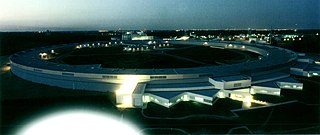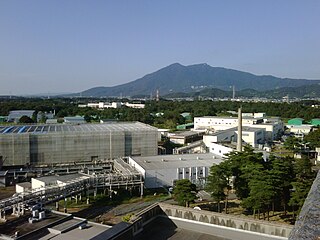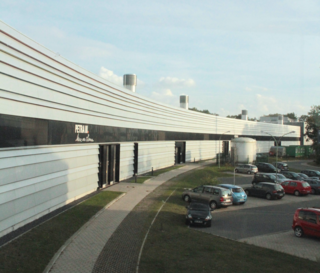Related Research Articles

DESY, short for Deutsches Elektronen-Synchrotron, is a national research centre for fundamental science located in Hamburg and Zeuthen near Berlin in Germany. It operates particle accelerators used to investigate the structure, dynamics and function of matter, and conducts a broad spectrum of interdisciplinary scientific research in four main areas: particle and high energy physics; photon science; astroparticle physics; and the development, construction and operation of particle accelerators. Its name refers to its first project, an electron synchrotron. DESY is publicly financed by the Federal Republic of Germany and the Federal States of Hamburg and Brandenburg and is a member of the Helmholtz Association.

A synchrotron light source is a source of electromagnetic radiation (EM) usually produced by a storage ring, for scientific and technical purposes. First observed in synchrotrons, synchrotron light is now produced by storage rings and other specialized particle accelerators, typically accelerating electrons. Once the high-energy electron beam has been generated, it is directed into auxiliary components such as bending magnets and insertion devices in storage rings and free electron lasers. These supply the strong magnetic fields perpendicular to the beam that are needed to stimulate the high energy electrons to emit photons.

Diamond Light Source is the UK's national synchrotron light source science facility located at the Harwell Science and Innovation Campus in Oxfordshire.

A synchrotron is a particular type of cyclic particle accelerator, descended from the cyclotron, in which the accelerating particle beam travels around a fixed closed-loop path. The magnetic field which bends the particle beam into its closed path increases with time during the accelerating process, being synchronized to the increasing kinetic energy of the particles. The synchrotron is one of the first accelerator concepts to enable the construction of large-scale facilities, since bending, beam focusing and acceleration can be separated into different components. The most powerful modern particle accelerators use versions of the synchrotron design. The largest synchrotron-type accelerator, also the largest particle accelerator in the world, is the 27-kilometre-circumference (17 mi) Large Hadron Collider (LHC) near Geneva, Switzerland, built in 2008 by the European Organization for Nuclear Research (CERN). It can accelerate beams of protons to an energy of 7 tera electronvolts (TeV or 1012 eV).

The Advanced Photon Source (APS) at Argonne National Laboratory is a storage-ring-based high-energy X-ray light source facility. It is one of five X-ray light sources owned and funded by the U.S. Department of Energy Office of Science. The APS began operation on March 26, 1995. It is operated as a user facility, meaning that it is open to the world’s scientific community, and more than 5,500 researchers make use of its resources each year.

The High Energy Accelerator Research Organization, known as KEK, is a Japanese organization whose purpose is to operate the largest particle physics laboratory in Japan, situated in Tsukuba, Ibaraki prefecture. It was established in 1997. The term "KEK" is also used to refer to the laboratory itself, which employs approximately 695 employees. KEK's main function is to provide the particle accelerators and other infrastructure needed for high-energy physics, material science, structural biology, radiation science, computing science, nuclear transmutation and so on. Numerous experiments have been constructed at KEK by the internal and international collaborations that have made use of them. Makoto Kobayashi, emeritus professor at KEK, is known globally for his work on CP-violation, and was awarded the 2008 Nobel Prize in Physics.

The Positron–Electron Tandem Ring Accelerator (PETRA) is one of the particle accelerators at the German national laboratory DESY in Hamburg, Germany. At the time of its construction, it was the biggest storage ring of its kind and still is DESY's second largest synchrotron after HERA. PETRA's original purpose was research in elementary particle physics. From 1978 to 1986, it was used to study electron–positron collisions with the four experiments JADE, MARK-J, PLUTO and TASSO. The discovery of the gluon, the carrier particle of the strong nuclear force, by the TASSO collaboration in 1979 is counted as one of the biggest successes. PETRA was able to accelerate electrons and positrons to 19 GeV.

SPring-8 is a synchrotron radiation facility located in Sayo Town, Sayo District, Hyōgo Prefecture, Japan, which is the main facility of Harima Science Garden City. It was developed jointly by RIKEN and the Japan Atomic Energy Research Institute, and is owned and managed by RIKEN, and run under commission by the Japan Synchrotron Radiation Research Institute. The machine consists of a storage ring containing an 8 GeV electron beam. On its path around the storage ring, the beam passes through insertion devices to produce synchrotron radiation with energies ranging from soft X-rays up to hard X-rays. The synchrotron radiation produced at SPring-8 is used for materials analysis and biochemical protein characterization by many Japanese manufacturers and universities.
The National Synchrotron Light Source (NSLS) at Brookhaven National Laboratory (BNL) in Upton, New York was a national user research facility funded by the U.S. Department of Energy (DOE). Built from 1978 through 1984, and officially shut down on September 30, 2014, the NSLS was considered a second-generation synchrotron.

Elettra Sincrotrone Trieste is an international research center located in Basovizza on the outskirts of Trieste, Italy.

ASTRID2 is a synchrotron light source at the Department of Physics and Astronomy of Aarhus University. ASTRID2 was designed, constructed and is operated by the Centre for Storage Ring Facilities in Aarhus (ISA).

The Swiss Light Source (SLS) is a synchrotron located at the Paul Scherrer Institute (PSI) in Switzerland for producing electromagnetic radiation of high brightness. Planning started in 1991, the project was approved in 1997, and first light from the storage ring was seen at December 15, 2000. The experimental program started in June 2001 and it is used for research in materials science, biology and chemistry.

The Synchrotron Radiation Source (SRS) at the Daresbury Laboratory in Cheshire, England was the first second-generation synchrotron radiation source to produce X-rays. The research facility provided synchrotron radiation to a large number of experimental stations and had an operating cost of approximately £20 million per annum.

MAX IV is a next-generation synchrotron radiation facility in Lund, Sweden. Its design and planning has been carried out within the Swedish national laboratory, MAX-lab, which up until 2015 operated three storage rings for synchrotron radiation research: MAX I, MAX II and MAX III. MAX-lab supported about 1000 users from over 30 countries annually. The facility operated 14 beamlines with a total of 19 independent experimental stations, supporting a wide range of experimental techniques such as macromolecular crystallography, electron spectroscopy, nanolithography and production of tagged photons for photo-nuclear experiments. The facility closed on 13 December 2015 in preparation for MAX IV.

A particle accelerator is a machine that uses electromagnetic fields to propel charged particles to very high speeds and energies, and to contain them in well-defined beams.
ANKA is a synchrotron light source facility at the Karlsruhe Institute of Technology (KIT). The KIT runs ANKA as a national synchrotron light source and as a large scale user facility for the international science community. Being a large scale machine of the performance category LK II of the Helmholtz Association, ANKA is part of a national and European infrastructure offering research services to scientific and commercial users for their purposes in research and development. The facility was opened to external users in 2003.

The National Synchrotron Light Source II (NSLS-II) at Brookhaven National Laboratory (BNL) in Upton, New York is a national user research facility funded primarily by the U.S. Department of Energy's (DOE) Office of Science. NSLS-II is one of the world's most advanced synchrotron light sources, designed to produce x-rays 10,000 times brighter than BNL's original light source, the National Synchrotron Light Source (NSLS). NSLS-II supports basic and applied research in energy security, advanced materials synthesis and manufacturing, environment, and human health.
An energy recovery linac (ERL) is a type of linear particle accelerator that provides a beam of electrons used to produce x-rays by synchrotron radiation. First proposed in 1965 the idea gained interest since the early 2000s.

The High Energy Photon Source (HEPS) is a diffraction-limited storage ring synchrotron light source producing hard x-ray radiations for scientific applications that will be built in the Huairou District in suburban Beijing, with estimated completion in 2025.

SOLARIS is the only synchrotron in Central-Eastern Europe. Built in Poland in 2015, under the auspices of the Jagiellonian University, it is located on the Campus of the 600th Anniversary of the Jagiellonian University Revival, in the southern part of Kraków. It is the central facility of the National Synchrotron Radiation Centre SOLARIS.
References
- ↑ Yabashi, Makina; Tanaka, Hitoshi (2017). "The next ten years of X-ray science". Nature Photonics. 11: 12–14. doi:10.1038/nphoton.2016.251.
- ↑ Streun, Andreas; Garvey, Terence; Rivkin, Lenny; Schlott, Volker; Schmidt, Thomas; Willmott, Philip; Wrulich, Albin (2018). "SLS-2 – the upgrade of the Swiss Light Source". Journal of Synchrotron Radiation. 25 (3): 631–641. doi:10.1107/S1600577518002722. PMC 5929351 . PMID 29714174.
- ↑ Alba Initiates Its Upgrade Process To Become A 4th Generation Facility
- ↑ Conceptual Design Report for SOLEIL Upgrade , accessed 24 April 2023.
- ↑ "China's next big thing: a new fourth-generation synchrotron facility in Beijing". Physics World. 2019-08-15. Retrieved 2023-09-15.
- ↑ "Groundbreaking Ceremony at the High Energy Photon Source in Beijing". Synchrotron Radiation News. 2019. pp. 32:5, 40–40.